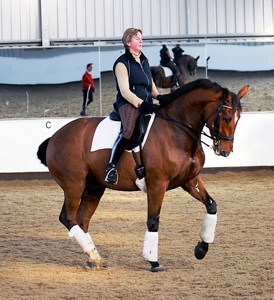
Philosophy

As a Young Rider, Louise was selected by the Dressage Group to participate in a number of schemes designed to expose upcoming riders to Continental trainers and their methods. She was one of ten Joicey Trainers sent abroad to observe some of the greatest dressage masters. These included Herbert Rehbein, George Theodorescu, Klaus Balkenhol and Ann Kathrin Linsenhoff . She was selected to ride at a Dressage Group convention under Herbert Rehbein and also Arthur Kottas of the Spanish Riding School. Louise was also invited by Lady Inchcape to participate in clinics given by Uwe Schulten Baumer and Henk van Bergen.
The benefit of this experience helped to form Louise's philosophy and approach to training. Her ethos is firmly based upon building a positive, confident relationship with the horse in order to progress through the scales of training. This system provides a firm base for developing the 'happy athlete' that we all aspire to own.
Louise believes that every horse should be treated as an individual, taking age, conformation, temperament and natural trainability into account. Her approach ensures that every horse, no matter what its talents is given the opportunity to achieve its maximum potential. She is therefore able to help all levels of horse and rider and has produced impressive results with clients of all abilities from Riding/Pony Club through affiliated up to National Championships level
Over twenty years of producing horses for showjumping, eventing and dressage has given Louise a great deal of experience dealing with different conformational types, breeds and ages of sport horses.
Louise draws on her experience of the multitude of horses that she has worked with over the years and has made some interesting observations about those that were successful, those that maintained long careers and those that despite showing superb talent as a youngster went on to experience problems as their training progressed.
Louise believes that the surface you ride your horse on has an enormous impact on its ability to maintain long term soundness. Maintaining a manege that is firm and flat but not hard so that the horse can work on top of it rather than in it is critical. Surfaces that move or slide away under the footing may well lead to joint problems.
Keeping the horse out and moving as much as possible is another one of Louise's firm beliefs. She turns her horses out daily and tries to split ridden work in the morning with a short spell on a rubber floored horsewalker in the afternoon. A change of scenery, for example boxing to the local gallops or to Great Westwood Park for some hillwork can really lift the horse and inspire him to be more forward thinking.
Some thoughts on working youngsters:
A proper fittening and strengthening programme is a must before starting more intense schooling, particularly in the less mature or weaker horse. Louise notices that the horses she produced early on in her career for dressage had often had other careers as showjumpers or eventers. Interestingly these horses went on to cope well with advanced level and Grand Prix work with less wear and tear and fewer physical injuries.
Consequently, Louise likes to produce young horses gradually and, if she feels any change in performance, will always take the trouble to investigate the possible physical cause and adjust work patterns accordingly.
She also incorporates pole work and jumping for some horses as this can be an excellent way to improve strength, coordination and athleticism.
The warm up is a vital element of any horse's training program and one that Louise insists on. Some time on the walker and then 5-10 minutes in walk under saddle followed by the correct stretching, loosening and suppleing in modest paces should precede the more demanding work. The warmdown is equally important and should involve stretching and another 5-10 minutes of walk. Remembering to keep muscles warm using exercise blankets in cold weather is also necessary.
Whatever your ability, an eye on the ground to monitor your performance and structure a work pattern to help you and your horse progress along the scales of training can be an inspiring and rewarding experience.
